
Broadway is a road in the U.S. state of New York. Broadway runs from the south at State Street at Bowling Green for 13 mi (20.9

The Upper West Side (UWS) is a neighborhood in the borough of Manhattan in New York City. It is bounded by Central Park on the east, the Hudson River on the west, West 59th Street to the south, and West 110th Street to the north. The Upper West Side is adjacent to the neighborhoods of Hell's Kitchen to the south, Columbus Circle to the southeast, and Morningside Heights to the north.
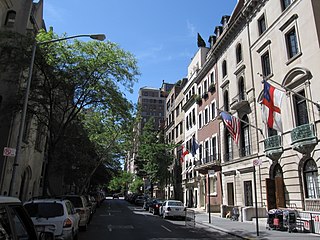
The Upper East Side, sometimes abbreviated UES, is a neighborhood in the borough of Manhattan in New York City, bounded approximately by 96th Street to the north, the East River to the east, 59th Street to the south, and Central Park and Fifth Avenue to the west. The area incorporates several smaller neighborhoods, including Lenox Hill, Carnegie Hill, and Yorkville. Once known as the Silk Stocking District, it has long been the most affluent neighborhood in New York City.

52nd Street is a 1.9-mile-long (3.1 km) one-way street traveling west to east across Midtown Manhattan, New York City, United States. A short section of it was known as the city's center of jazz performance from the 1930s to the 1950s.

The 66th Street–Lincoln Center station is a local station on the IRT Broadway–Seventh Avenue Line of the New York City Subway. Located at the intersection of 66th Street and Broadway in the Lincoln Square neighborhood of Manhattan, it is served by the 1 train at all times and by the 2 train during late nights.
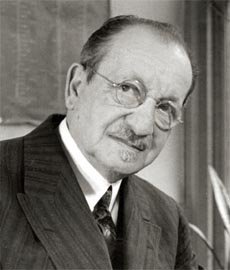
Emery Roth was a Hungarian-American architect of Hungarian-Jewish descent who designed many New York City hotels and apartment buildings of the 1920s and 1930s, incorporating Beaux-Arts and Art Deco details. His sons continued in the family enterprise, largely expanding the firm under the name Emery Roth & Sons.
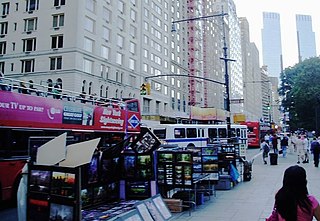
59th Street is a crosstown street in the New York City borough of Manhattan, running from York Avenue and Sutton Place on the East Side of Manhattan to the West Side Highway on the West Side. The three-block portion between Columbus Circle and Grand Army Plaza is known as Central Park South, since it forms the southern border of Central Park. There is a gap in the street between Ninth Avenue/Columbus Avenue and Columbus Circle, where the Deutsche Bank Center is located. While Central Park South is a bidirectional street, most of 59th Street carries one-way traffic.
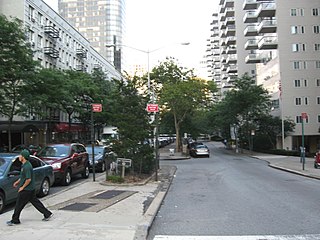
66th Street is a crosstown street in the New York City borough of Manhattan with portions on the Upper East Side and Upper West Side connected across Central Park via the 66th Street transverse. West 66th Street is notable for hosting the Lincoln Center for the Performing Arts between Broadway and Columbus Avenue.
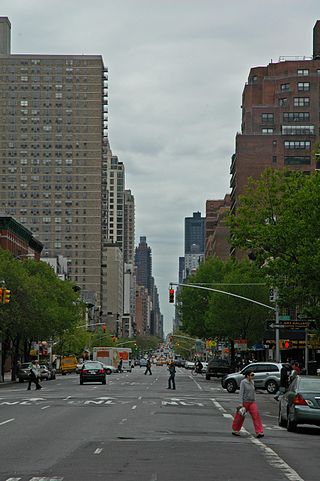
85th Street is a westbound-running street, running from East End Avenue to Riverside Drive in the borough of Manhattan in New York City, United States.

The El Dorado is a cooperative apartment building at 300 Central Park West, between 90th and 91st Streets adjacent to Central Park, on the Upper West Side of Manhattan in New York City. It was constructed from 1929 to 1931 and was designed by architect of record Margon & Holder and consulting architect Emery Roth in the Art Deco style. The El Dorado consists of twin 12-story towers rising from a 17-story base. The building is a contributing property to the Central Park West Historic District, a National Register of Historic Places–listed district, and is a New York City designated landmark.

93rd Street is a one-way street in the New York City borough of Manhattan. Like most of Uptown Manhattan east–west streets crossing Central Park, it is split in two segments. Its west segment traverses the Upper West Side and runs from Riverside Drive to Central Park West, while its east segment traverses the Upper East Side and runs from 5th Avenue to East End Avenue.

Grand Army Plaza is a public square at the southeast corner of Central Park in Manhattan, New York City, near the intersection of Fifth Avenue and Central Park South. It consists of two rectangular plots on the west side of Fifth Avenue between 58th and 60th streets. The current design of Grand Army Plaza dates to a 1916 reconstruction by the architectural firm of Carrère and Hastings. The plaza is designated as a New York City scenic landmark.
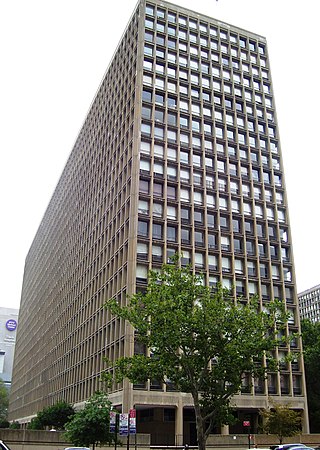
Kips Bay Towers is a 1,118-unit, two-building condominium complex in the Kips Bay neighborhood of Manhattan in New York City. The complex was designed by architects I.M. Pei and S. J. Kessler, with the involvement of James Ingo Freed, in the brutalist style and completed in 1965. Originally known as Kips Bay Plaza, the project was developed by Webb & Knapp as middle-income rental apartments, but was converted to condominiums in the mid-1980s.
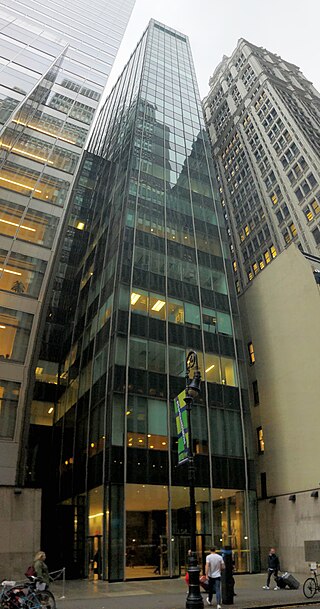
The Springs Mills Building is a 21-story office building at 104 West 40th Street in Manhattan, New York City, just west of Sixth Avenue and Bryant Park. The Modernist building sits on an L-shaped lot that extends back to 39th Street and rises to a thin glass hexagonal tower. An early example of the International Style in New York, the building was designed by the architectural firm Harrison & Abramovitz and built in 1961–1963. Its northern facade on 40th Street is designed to comply with the 1961 Zoning Resolution, enacted soon after the building's construction started, while its southern facade on 39th Street conforms to the older 1916 Zoning Resolution.

Manhattan House is a 21-story residential condominium building at 200 East 66th Street on the Upper East Side of Manhattan in New York City. The building was designed in the modern style by Gordon Bunshaft of Skidmore, Owings & Merrill (SOM), in partnership with the firm of Albert Mayer and Julian Whittlesey. It occupies a full city block bounded by Third Avenue to the west, 66th Street to the north, Second Avenue to the east, and 65th Street to the south. Constructed between 1949 and 1951, Manhattan House was developed by the New York Life Insurance Company as a middle-class apartment building. The complex is a New York City designated landmark.
Stephen C. Lyras was an American architect.
John M. Kokkins was a Greek-American architect.
















